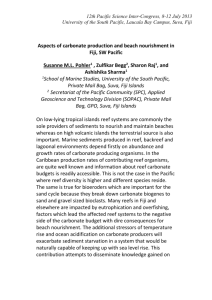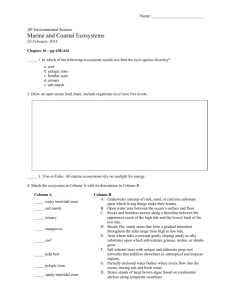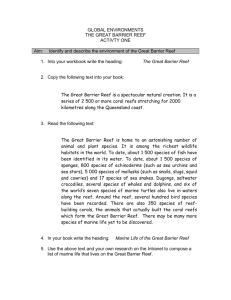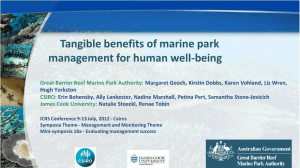Shallow marine carbonate environments
advertisement
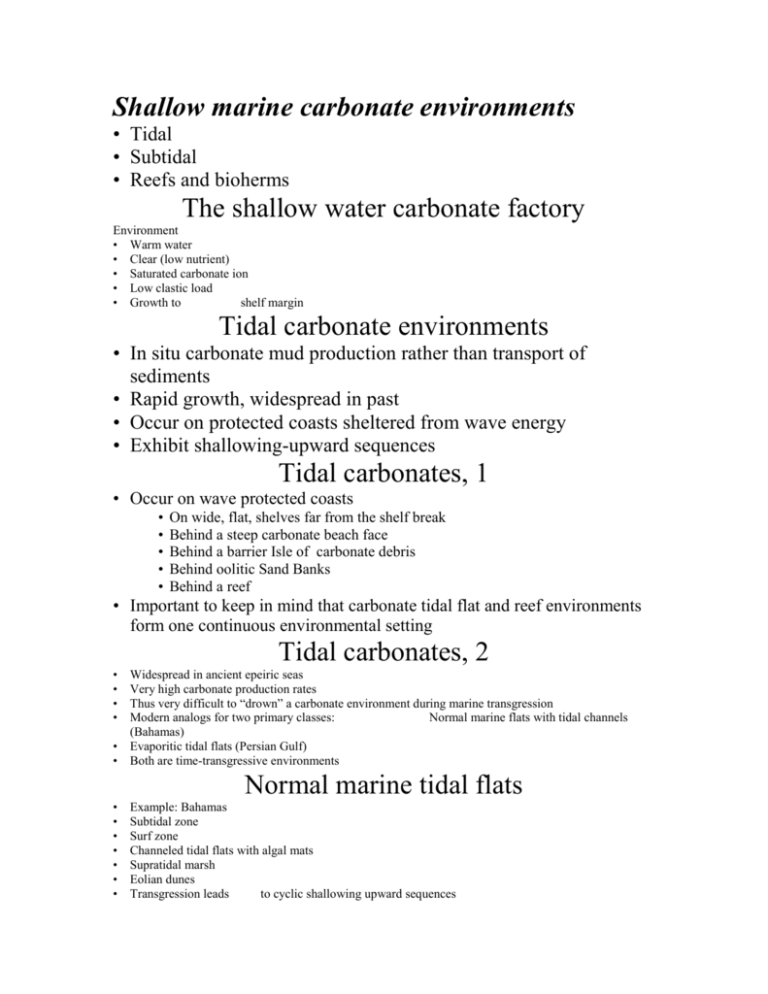
Shallow marine carbonate environments • Tidal • Subtidal • Reefs and bioherms The shallow water carbonate factory Environment • Warm water • Clear (low nutrient) • Saturated carbonate ion • Low clastic load • Growth to shelf margin Tidal carbonate environments • In situ carbonate mud production rather than transport of sediments • Rapid growth, widespread in past • Occur on protected coasts sheltered from wave energy • Exhibit shallowing-upward sequences Tidal carbonates, 1 • Occur on wave protected coasts • • • • • On wide, flat, shelves far from the shelf break Behind a steep carbonate beach face Behind a barrier Isle of carbonate debris Behind oolitic Sand Banks Behind a reef • Important to keep in mind that carbonate tidal flat and reef environments form one continuous environmental setting Tidal carbonates, 2 • • • • • • Widespread in ancient epeiric seas Very high carbonate production rates Thus very difficult to “drown” a carbonate environment during marine transgression Modern analogs for two primary classes: Normal marine flats with tidal channels (Bahamas) Evaporitic tidal flats (Persian Gulf) Both are time-transgressive environments • • • • • • • Example: Bahamas Subtidal zone Surf zone Channeled tidal flats with algal mats Supratidal marsh Eolian dunes Transgression leads to cyclic shallowing upward sequences Normal marine tidal flats • Regression can result in stressed environments Subtidal and reef carbonates • • • • Provide barrier to tidal carbonate environments Oolitic shoals Reefs Bioherms (Build ups) Oolitic sands, Bahama Bank Modern oolitic sands and stromatolites Subtidal shelf carbonate • • • • • Below mean wave base to depths of 100-200 m Normal marine conditions Mixture of skeletal sand and mud Less regular bed thickness than tidal flats; flow structure present Intensive bioturbation • Modern examples – – – – – – Florida Coast Persian Gulf Yucatan Coast Bermuda Bahamas Great Barrier Reef Ancient examples • Carbonate production can keep pace with slow subsidence or sea level rise • Tremendous thickness: 2-3 km sediment • Cretaceous seaway of North America, Mexico • Triassic Dolomites of the Italian Alps Example: Sediments of an epicontinental sea Cretaceous Seaway of N. America • Sea level high stand (Ice-free conditions?) • Marginal Marine - Marine sediments • Vast epicontinental sea• 5000 km long by 1400 km wide • Approximately 300 m at greatest depth • 2200 m of marine sediments Depositional environments and associated sediments • • • • Deep water - pelagic shale and chalk Shelf - Rim of shale and sandstone Coastal plain deposits - terrestrial shale, sandstone and conglomerates Transgressive/regressive facies changes in response to SL changes and orogeny of Rocky mountains. • • • • Fringing reefs Tidal mudflats Oolitic shoals Grapestone regions represent less protected, zones of lower accumulation rate Great Bahama Bank, 1 • Great Bahama Bank, 2 Area of 100,000 km2 • Average water depth 5m • Oolitic shoals indicate high energy conditions • Exports large amount of aragonitic mud to the deep sea Reefs and Buildups • Buildups - any bio-precipitated carbonate rock with topographic relief above surrounding environment • Reef - buildup of a wave-resistent framework within the wave zone • Bioherm or biostome - in situ accumulation of non binding benthic calcifers • Framework builders account for only ~10% of Reef! Geometry • Fringing • Barrier • Atoll • “Spur and groove” Reef type sequence Spur and groove on Fringe reef in Taiwan Vertical zonation of reef environments Progradation and aggradation on carbonate margins Modern carbonate environments Sources of limestone sand & mud • Coralgal sand on outer reef • Fine grained carbonate in back reef Evidence for in situ production of back reef lime muds • • • Composition of mud from modern lagoon/tidal flat environment differs from reef carbonate Data indicates calcitic algae grow at sufficient rates in back reef environs to explain recent sediment accumulation Typical lime mud production rates are similar (10’s to 100’s of cm/kyr) although reef environment may have rates up to 2x greater than lagoon/tidal flats Limestone facies and depth ranges Vertical zonation of coral species • Reef crest (~1-6m) A. palmata • Forereef (~3-12m) A. cervicornis • Deep water (>12m) Monastrea, Siderastrea, Diploria sp. Example of ancient reef facies Reef builders through time Sample exam question Q. Modern observations demonstrate that the coral species A. palmata grows over a depth range from ~1-6 meters. Yet Late Pleistocene reef deposits from the Caribbean often include in place layers of A. palmata 20-30m thick. Describe three hypotheses that might explain these results.


